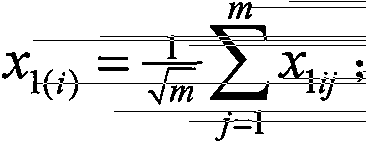Method for detecting randomicity of pseudorandom sequence based on random permutation
A pseudo-random sequence, randomness detection technology, applied in the field of randomness detection of pseudo-random sequences
- Summary
- Abstract
- Description
- Claims
- Application Information
AI Technical Summary
Problems solved by technology
Method used
Image
Examples
Embodiment 1
[0034] Embodiment 1, the randomness detection of the pseudo-random sequence is realized by inverting the sequence to be tested. Specific steps are as follows:
[0035] Step 1, input the sequence to be tested a 1 , a 2 ,...,a n , n=10 6 .
[0036] Step 2, find the sequence to be tested a 1 , a 2 ,...,a n The inverse sequence, get a n , a n-1 ,...,a 1 .
[0037] Step 3, use the Cramér-von Mises test method to perform statistics on the reverse sequence:
[0038] a) set the length to 10 6 the reverse sequence of a n , a n-1 ,...,a 1 Divide into 100 small groups with a length of 10000, record m=10000, N=100, where 10000 and 100 are optional;
[0039] b) let x 1ij Represents the j-th bit in the i-th small group, i=1, 2, L, N, j=1, 2, L, m, construct statistics x 1 ( i ) = 1 m ...
Embodiment 2
[0050] In the second embodiment, the randomness detection of the pseudo-random sequence is realized by inverting the sequence to be tested. Specific steps are as follows:
[0051] Step 1, input the sequence to be tested a 1 , a 2 ,...,a n , n=10 6 .
[0052] Step 2, find the sequence to be tested a 1 , a 2 ,...,a n The inverse sequence, get a 1 , a 2 ,...,a n , where a i =(1+a i ) mod2, 1≤i≤n.
[0053] Step 3, use the Cramér-von Mises test method to perform statistics on the reverse sequence:
[0054] 1) set the length to 10 6 the reverse sequence of a 1 , a 2 ,...,a n Divide into 20 small groups with a length of 50000, record m=50000, N=20, where 50000 and 20 are optional;
[0055] 2) let x 2ij Represents the j-th bit in the i-th small group, i=1, 2, L, N, j=1, 2, L, m, construct statistics x 2 ( i ) = 1 ...
Embodiment 3
[0064] In the third embodiment, the randomness detection of the pseudo-random sequence is realized by performing random interleaving on the sequence to be tested. Specific steps are as follows:
[0065] Step A, input the sequence to be tested a 1 , a 2 ,...,a n , n=10 6 .
[0066] Step B, the sequence to be tested a 1 , a 2 ,...,a n Perform random interleaving.
[0067] According to the length n of the sequence to be tested, initialize the set I={1, 2, L, n}, randomly select an integer s from the set I 1 denoted as S(1), and s 1 Deleted from set I, the new set obtained is denoted as I 1 ;
[0068] At step k, from set I k-1 ={s∈I, s≠s 1 ,L,s k-1 } randomly selects an integer s k denoted as S(k), and s k from set I k-1 deleted, and the new set obtained is denoted as I k , k=2,3,L,n;
[0069] When k=n, S(n) is obtained, and random interleaving is completed;
[0070] According to the S(1), S(2), L, S(n) obtained above, the random interleaving...
PUM
 Login to View More
Login to View More Abstract
Description
Claims
Application Information
 Login to View More
Login to View More - R&D
- Intellectual Property
- Life Sciences
- Materials
- Tech Scout
- Unparalleled Data Quality
- Higher Quality Content
- 60% Fewer Hallucinations
Browse by: Latest US Patents, China's latest patents, Technical Efficacy Thesaurus, Application Domain, Technology Topic, Popular Technical Reports.
© 2025 PatSnap. All rights reserved.Legal|Privacy policy|Modern Slavery Act Transparency Statement|Sitemap|About US| Contact US: help@patsnap.com



